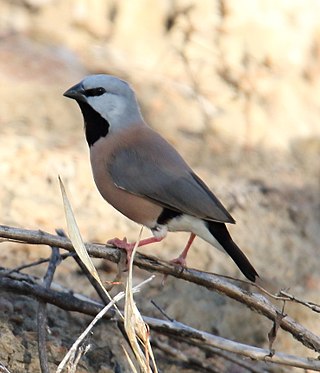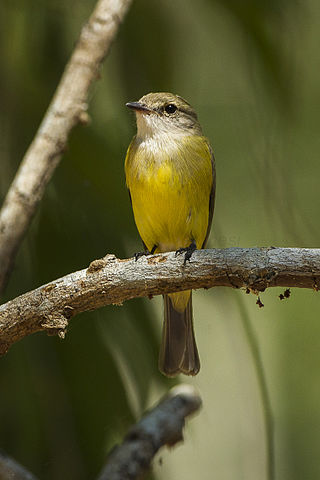
The pied currawong is a black passerine bird native to eastern Australia and Lord Howe Island. One of three currawong species in the genus Strepera, it is closely related to the butcherbirds and Australian magpie of the family Artamidae. Six subspecies are recognised. It is a robust crowlike bird averaging around 48 cm (19 in) in length, black or sooty grey-black in plumage with white undertail and wing patches, yellow irises, and a heavy bill. The male and female are similar in appearance. Known for its melodious calls, the species' name currawong is believed to be of indigenous origin.

The crimson rosella is a parrot native to eastern and south eastern Australia which has been introduced to New Zealand and Norfolk Island. It is commonly found in, but not restricted to, mountain forests and gardens. The species as it now stands has subsumed two former separate species, the yellow rosella and the Adelaide rosella. Molecular studies show one of the three red-coloured races, P. e. nigrescens, is genetically more distinct.

The Gouldian finch, also known as the Gould's finch or the rainbow finch, is a colourful passerine bird that is native to Australia.

The red-tailed black cockatoo also known as Banksian- or Banks' black cockatoo, is a large black cockatoo native to Australia. Adult males have a characteristic pair of bright red panels on the tail that gives the species its name. It is more common in the drier parts of the continent. Five subspecies are recognised, differing chiefly in beak size. Although the more northerly subspecies are widespread, the two southern subspecies, the forest red-tailed black cockatoo and the south-eastern red-tailed black cockatoo are under threat.

Threatened fauna of Australia are those species and subspecies of birds, fish, frogs, insects, mammals, molluscs, crustaceans, and reptiles to be found in Australia that are in danger of becoming extinct. This article lists species classified as threatened species under the Commonwealth Environment Protection and Biodiversity Conservation Act 1999.

The glossy black cockatoo, is the smallest member of the subfamily Calyptorhynchinae found in eastern Australia. Adult glossy black cockatoos may reach 50 cm (19.5 in) in length. They are sexually dimorphic. Males are blackish brown, except for their prominent red tail bands; the females are dark brownish with some yellow spotting. Three subspecies are recognised.

The red-browed finch is an estrildid finch that inhabits the east coast of Australia. This species has also been introduced to French Polynesia. It is commonly found in temperate forest and dry savannah habitats. It may also be found in dry forest and mangrove habitats in tropical region.

The weebill is a species of bird in the family Acanthizidae. It is an insectivorous passerine that is found throughout mainland Australia. At 8 to 9 cm long, it is Australia's smallest bird. It was originally described by John Gould in 1838, and four subspecies are recognised. The weebill's plumage is nondescript, with olive-grey upperparts and paler, more yellowish underparts. It grades from more brownish plumage in the southern regions of Australia to more yellow in tropical areas.

The white-throated honeyeater is a bird of the honeyeater family Meliphagidae native to New Guinea and eastern and northern Australia. It is 11.5 to 14.5 cm long, olive-green above and white below, with a black head, a white or pale blue patch over the eye, and a white stripe across the nape.

The diamond firetail is a species of estrildid finch that is endemic to Australia. It has a patchy distribution and generally occupies drier forests and grassy woodlands west of the Great Dividing Range from South East Queensland to the Eyre Peninsula in South Australia. While it is a small stocky bird it is one of the largest finches in Australia. The birds are very distinctive with a black breast-band on a white breast. The flanks are black with white spots and it has a scarlet rump and a black tail.

The crimson finch is a species of bird in the family Estrildidae. It is found throughout Northern Australia as well as parts of southern New Guinea. Crimson finches feature a distinctively bright crimson coat and are known for their aggression.

The plum-headed finch also known as cherry finch is a common species of estrildid finch found in Australia. It is the only species placed in the genus Aidemosyne. It has an estimated global extent of occurrence of 100,000 – 1,000,000 km2.

The long-tailed finch is a common species of estrildid finch found in northern Australia, from the Kimberley region to the Gulf of Carpentaria. It is a predominantly fawn-coloured bird with a pale grey head and prominent black bib and eyes. It inhabits dry savannah habitats in Australia and adapts readily to aviculture.

The black-throated finch, or parson finch, is a species of estrildid finch found in grassy woodlands throughout north-east Australia from Cape York Peninsula to central Queensland. The southern black-throated finch is endangered, with a population in decline and its habitat is threatened by development, and has become extinct in New South Wales, while the northern black-throated finch is not listed as threatened at this point.

The pale-vented bush-hen is a medium sized waterbird, mainly blue-grey with a buff vent and undertail. It is found in Australia, the Moluccan Islands, New Guinea, the Bismarck Archipelago and the Solomon Islands. Its natural habitat is subtropical or tropical moist lowland forests.

The fairy gerygone, previously known as the fairy warbler, is a species of bird in the family Acanthizidae native to New Guinea and Queensland.

The pictorella mannikin, pictorella munia, or pictorella finch is small brown and grey finch with a grey bill and distinctive scaly white breast plate which is endemic to northern Australia. It is a seed-eater found in pairs and small flocks in dry savannah and subtropical or tropical dry lowland grassland.

The lemon-bellied flyrobin or lemon-bellied flycatcher is a species of bird in the family Petroicidae. Found in Australia, Indonesia, and Papua New Guinea, its natural habitats are subtropical or tropical moist lowland forests and subtropical or tropical mangrove forests.




















